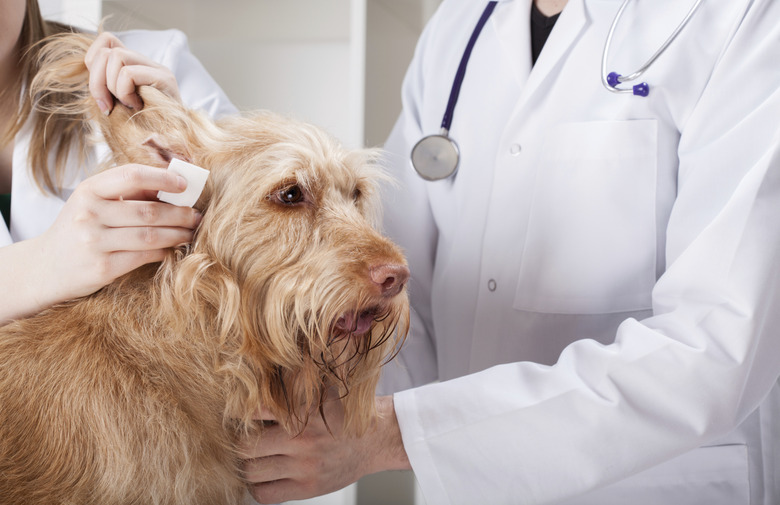Antibiotic Side Effects In Dogs
Take comfort in knowing that canine antibiotics are typically safe and serious side effects are rare. Gastrointestinal discomfort is often seen with many antibiotic classes and should be monitored to prevent secondary issues such as dehydration, but long-term issues are uncommon. Never give your dog antibiotics without your veterinarian's prescription and follow her instructions precisely to prevent antibiotic resistance.
Fluoroquinolones
Fluoroquinolones
If your dog gets an ear or skin infection, or pneumonia, your vet may prescribe a fluoroquinolone: ciproflaxin, marbofloxacin, sold as Zeniquin; orbifloxacin or enrofloxacin. Side effects include an upset stomach, particularly if your dog takes the drug for a long period. Giving the drug with food may help. Contact your vet if the side effects worsen over time; don't stop giving him the drug without your veterinarian's consent. If your dog is on fluoroquinolone for 14 days without improvement, contact your veterinarian — long-term use can lead to long-term problems. Fluoroquinolones should not be given to puppies.
Aminoglycosides
Aminoglycosides
Streptomycin, neomycin and gentamicin are some common antibacterial antibiotics in the aminoglycosides group. Your vet may prescribe this for respiratory or ear infections, or infections of the blood, skin or internal organs. It's imperative you tell your vet if your dog has kidney or liver problems, or if your dog has not been drinking water. Your dog may experience digestive upsets; notify your vet if your dog seems shaky, has muscle spasms or suddenly has difficulty hearing.
Cephalosporins
Cephalosporins
Your dog's serious cut, abscess or urinary tract infection may call for a cephalosporin, such as cefadoxil or cephalexin. Inform your vet if your dog is allergic to penicillin, is taking any other medications — particularly aminoglycosides — or if he has kidney disease. Fortunately, side effects are rare; the most common are digestive upsets, but your dog may also become excited and experience rapid breathing. You may also notice increased drool.
Imidazoles
Imidazoles
Imidazoles work to defeat yeast and other fungus infections, and are customary topical prescriptions. Common names are clotrimazole, miconazole, econazole, ketoconazole, itraconazole, fluconazole and thiabendazole. Ketoconazole is the one most likely to cause side effects, particularly nausea and vomiting. Let your vet know if your dog is taking other medications or antacids.
Pencillins
Pencillins
Penicillin is the granddaddy of antibiotics, used for a wide spectrum of bacterial infections. It also has the most bacteria resistant to it. There are many forms, but ampicillin and amoxicillin are among the most common for dogs. Let your veterinarian known if your dog is currently taking cephalosporin, aminoglycosides or bacteriostatics. In addition to gastrointestinal upsets, your dog may experience fever, joint pain, or a rash. Watch for other signs of an allergic reaction, as this can affect your dog's future antibiotic options.
Sulfonamides
Sulfonamides
What penicillin is to human physicians, the sulfonamide drug class is to veterinarians: This is the oldest and most widely used antibiotic class in veterinarian medicine. Sulfasalzine; sulfadiazine; sulfadimethoxine, sold as Primor; and trimethoprim sulfa are some names in this class. Many forms are for specific infections, ranging from urinary tract infections, to those caused by burns. These drugs are most effective when started early. Tell your veterinarian if your dog is taking antacids or has liver disease. Side effects may include inflamed joints and muscle soreness, fever and kidney problems.
Tetracyclines
Tetracyclines
Your dog is likely to take tetracycline for any tick-borne disease such as Lyme disease. It is also used for many other bacterial infections. Doxycycline and minocycline are two long-acting forms; other types include methacycline and lymecycline. This class interacts with several other drugs and supplements your dog might be taking, so thoroughly detail these to your veterinarian. Side effects include gastrointestinal upsets, including difficulties eating. Your dog may be sensitive to light and display discoloration in his teeth. Young dogs may have delayed bone growth. It may also cause liver, kidney and blood diseases.
Chloramphenicol
Chloramphenicol
Chloramphenicol is a powerful antibiotic effective against a variety of infections. Adhere strictly to your veterinarian's instructions — 1 in 10,000 humans exposed to chloramphenical acquire permanent bone marrow damage, so you must wear gloves and a mask when handling, administering, or cleaning up any feces or vomit. It's often ground and mixed with food due to an extremely bitter taste. Chloramphenicol can cause circulatory problems, and should not be given to puppies or dogs with blood or circulatory issues. Gastrointestinal side effects are common; dogs with liver or kidney issues shouldn't take this drug. Postpone vaccinations, as it may inhibit a proper response to them. Make no changes to your dog's diet while he's on chloramphenicol. Return any unused portions of this drug to your veterinarian for proper disposal.
Always check with your veterinarian before changing your pet's diet, medication, or physical activity routines. This information is not a substitute for a vet's opinion.
References
- Dogs Naturally Magazine: Three Things Every Dog Owner Should Know About Antibiotics
- DrBarchas.com: Fluoroquinolone Antibiotics
- The Merck Veterinary Manual: Aminoglycosides
- Doctors Foster & Smith: Cephalosporins
- The Merck Veterinary Manual: Imidazoles
- PetMD: Penicillin
- The Merck Veterinary Manual: Penicillins
- The Merck Veterinary Manual: Sulfonamides and Sulfonamide Combinations
- Veterinary Specialty Center Tucson: Internal Medicine: Sulfa Drug Toxicities
- PetMD: Tetracycline
